

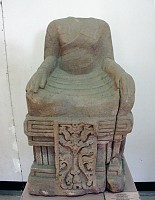
|
Buddha, sandstone, late 9th century, Dong Duong, Thang Binh district, Quang Nam provinceThis Buddha sits on a square pedestal with his hands placed on his knees. The base is carved with a vermiculated motif, typical of the Dong Duong style (Hop 42). | |
Prajnaparamita, sandstone, 9th century, Dai Huu, Quang Binh provinceThe facial features, characteristic of Dong Duong style, include elongated eyes, a small forehead, flaring nostrils, and full upturned lips. |

|
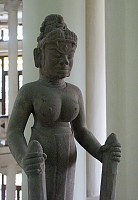
|
Left: Dancer with Scarves, sandstone, 10th century, Tra Kieu, Duy Xuyen district, Quang Nam provinceThis dancer, part of architectural decoration, curves in three places--the head, the torso and the legs. Her loin cloth sways with her body. She wears an elaborate headdress. | ||
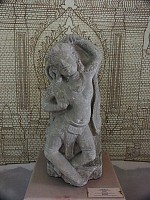
|

|
Center: Makara giving life to the Asura, sandstone, 10th-11th century, Tra Kieu, Duy Xuyen district, Quang Nam provinceThis architectural decoration depicts an Asura (a kind of demon) in the maw of Makara--depicted in Tra Kieu style with a pig's ear, elephant trunk upper lip, and bug eyes. The mythical makara has various forms in different Asian cultures. |
Left: Body of Garuda, sandstone; center: Head of Garuda, sandstone; right: Lion, sandstone--all 10th century and all from Tra Kieu, Duy Xuyen district, Quang Nam provinceThe Garuda is usually depicted with bird wings and face, usually more like an eagle, although in the center example, its beak is more like a duck's bill. The horned lion is standing in combat pose. | ||
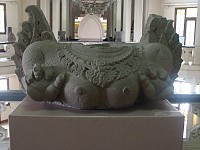
|
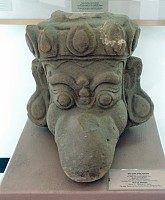
|

|
Elephants, sandstone, 10th century, both from Tra Kieu, Duy Xuyen district, Quang Nam provinceThese naturalistic elephants seem to be walking (with front leg raised); the trunk curls upward. |

|
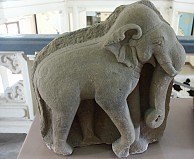
|
Left: Musician playing the flute, sandstone, 11th-12th century, Chien Dan, Tam Ky town, Quang Nam province; center: Shiva, sandstone, 12th century, Thap Mam, An Nhon district, Binh Dinh province; Ascetic, sandstone, late 12th century, Thap Mam, An Nhon district, Binh Dinh provinceShiva is identified because she carries the trisula in her lower left hand. Her upper arms are weirdly attached to the back of her shoulders and her dancing is portrayed by bent legs. The hermit figure is in an arched niche, wears a loin cloth and conical headdress and holds something like rosary beads. | ||
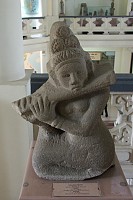
|
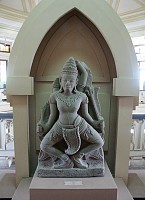
|
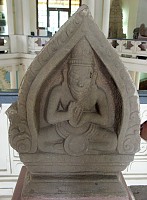
|
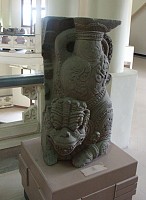
|
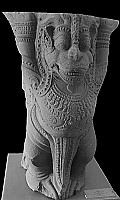
|
Lions, sandstone; the left lion dated at late 12th century, the center at 13th century, both from Thap Mam, An Nhon district, Binh Dinh provinceThe snarling lion has a mask-like face. The decorative qualities and incised details of both lions are characteristic of the Thap Mam style. |
Lion, sandstone, 13th century, Binh Dinh province.This lion is more like a mythical creature than a naturalistic animal. The decorative qualities are characteristic of the Thap Mam style. Its loin cloth has three folds, its jewelry is elaborate (necklace, and arm bands), and the face is mask-like.This and the sculpture below are outside in the museum's sculpture garden. |
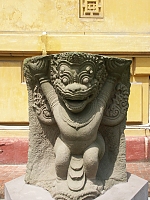
| |
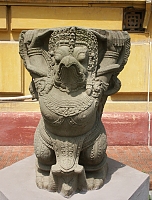
|
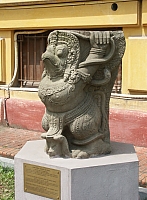
|
Garuda and Naga, sandstone, 13th century, Thap Mam, An Nhon district, Binh Dinh provinceThe winged bird-faced creature holds a naga (snake) in its raised hands. The incised decorative motifs signal the Thap Mam style. |
 Click here to go to the Vietnam Index.
Click here to go to the Vietnam Index.
 Click here to return to index of art historical sites.
Click here to return to index of art historical sites.
 Click here to return to index of artists and architects.
Click here to return to index of artists and architects.
 Click here to return to chronological index.
Click here to return to chronological index.
 Click here to see the home page of Bluffton University.
Click here to see the home page of Bluffton University.
